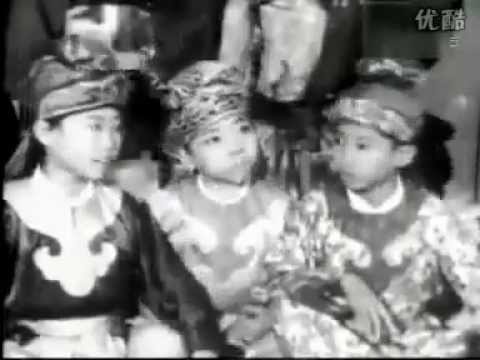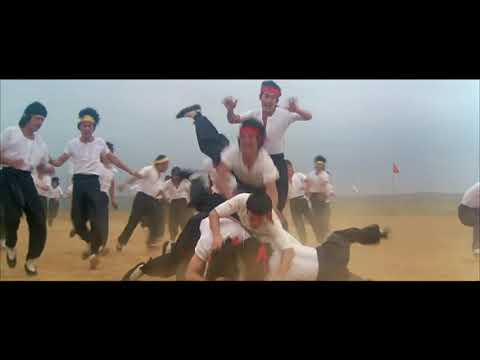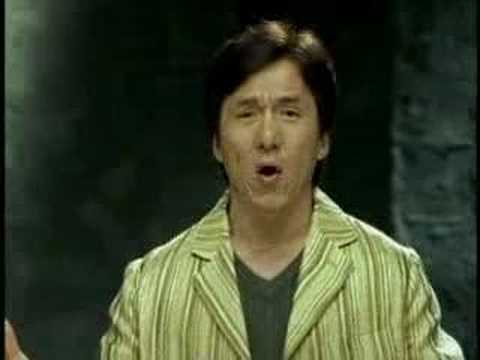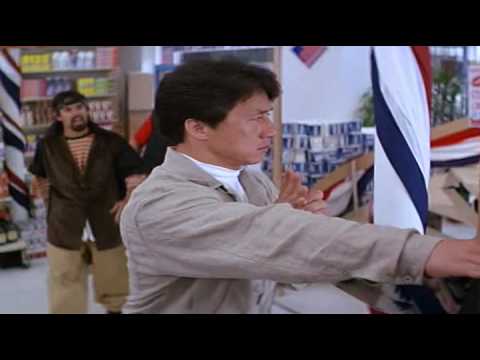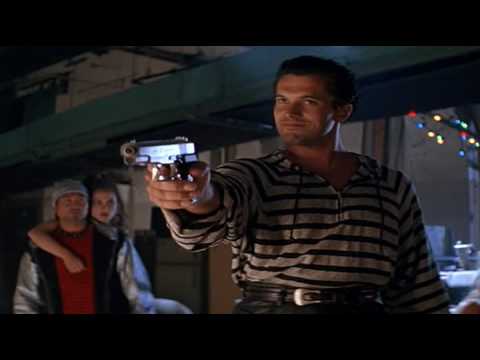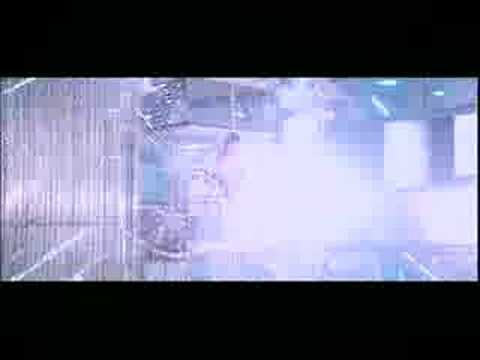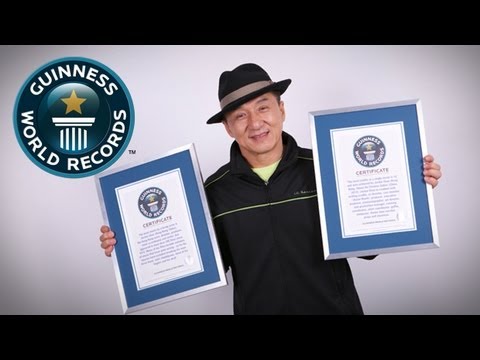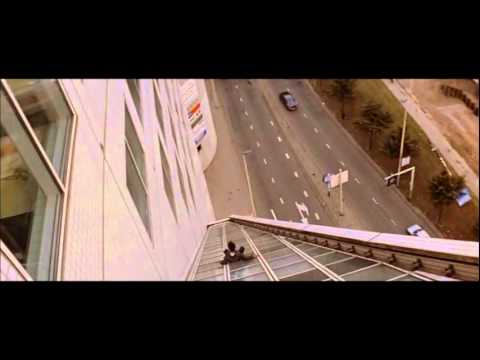10 A Tough Childhood
Jackie’s parents seem to be characters right out of one his movies. Before World War II, Jackie’s dad Charles was a spy for the Chinese Nationalist government. Mom, Lee-Lee, was a stage performer who sold opium on the side. As part of his duties as a spy, Charles arrested Lee-Lee then married her. He had two sons from a previous marriage; she had two daughters. To support his newly huge family, Charles joined the Chinese mafia. When the communists took over China in 1949, Charles and Lee-Lee fled to Hong Kong, leaving their four children behind. Jackie’s biographer Mabel Cheung says this was not unusual. Kids all over mainland China were abandoned because of the communist takeover. Jackie was born five years later and was named “Chan Kong-sang,” which means “born in Hong Kong.” His parents tried to sell him to the British doctor who delivered him for $26. When he was seven, his parents headed for Australia in search of jobs, leaving Jackie in a Hong Kong boarding school. School started at 5:00 AM and ended at midnight. In between, he learned acrobatics, drama, and martial arts and was classically trained in music. Any mistake was answered with corporal punishment. “I was beaten every day,” he said later. “I was very angry.” Reading, writing, and academics were not taught. While Jackie can now speak and sing in seven languages, he still struggles with literacy. At eight, Jackie had a small part in his first movie, Big and Little Wong Tin Bar, and by the time he graduated from school in 1971, he had several film credits. Chan worked as an acrobat and stuntman, and he was one of the adversaries whom Bruce Lee dispatched in Fist of Fury and Enter the Dragon. After Bruce Lee’s death, promoter Willie Chan featured Jackie as the new Bruce Lee in a number of forgettable films. But Jackie wanted to establish his own screen identity, one that incorporated comedy, extreme athleticism, and martial arts. He finally achieved it with his film Drunken Master. To fully appreciate his style in the film, realize that the Hong Kong movie industry was still enamored with the Bruce Lee style of posing, screeching, dispatching the bad guy, and then posing again. Jackie’s revolutionary style was more fluid and, while a little hokey, more humorous.
9 A Perfectionist
We’ve heard the stories about difficult directors. While directing City Lights, Charlie Chaplin redid a scene 300 times just to get Virginia Cherrill to hold a rose at the perfect angle. David Fincher is famous for his multiple takes, and a producer of his film Gone Girl (set to be released in October 2014) said that he averages 50 takes for each scene. But Jackie has them all beat with 2,900 takes for a single 10-minute scene. Jackie took over as director of his 1982 film Dragon Lord. The movie opens with an elaborate sequence where Jackie and dozens of stuntmen play jianzi, a game where players kick a feathered shuttlecock. The scene was originally supposed to be the movie’s climax, but Jackie wanted the film to start with a bang. The competition features numerous acrobatic feats and just one kick by Jackie, and this kick required hundreds of takes to get just the right angle and timing. Guinness World Records awarded Jackie the record for most takes for a single scene. “People say Jackie Chan is slow,” he said in an interview, referring to his retakes. “I’ll film the movement until it’s the way I like it. That way, I know my fans will like it.” The above video is of the trailer for that movie. You can see some of the scene at the three-minute mark.
8 Jackie’s Best Fight Scene
Martial arts fans have several favorite movie fight scenes: Bruce Lee versus Chuck Norris in Return of the Dragon, Jet Li versus Billy Chow in Fist of Legend, or Jen Yu against Yu Shu Lien in Crouching Tiger, Hidden Dragon. But one fight scene stands out and is on nearly everyone’s list as one of the best fight scenes ever filmed: the final fight in 1984’s Wheels on Meals between Jackie and Benny “The Jet” Urquidez. Chan is not well known for his kickboxing, so it was something of a surprise when he took on Urquidez, the undefeated kickboxing champion of the world. Urquidez was the first American to ever win a karate championship in Japan against a Japanese opponent, and he had a huge following in America and Asia. While filming the fight scene, Urquidez actually hit Chan—he would not or could not pull his punches. Angry, Jackie landed a few blows of his own and began taunting Urquidez that they should have a real exhibition bout. Urquidez warned Jackie that he was a professional and would hurt Jackie in such an exhibition. The other actors and crew began taking bets on the likelihood that tempers would flare and a real fight would erupt. Urquidez’s nickname “The Jet” does not originate from the famous Elton John song “Bennie and the Jets” as some have claimed, but from his lethal spinning back kick. One gag during the fight was meant to showcase that move. Urquidez was to push Jackie against a table with candles. He’d then throw a spinning heel kick that misses Jackie but blows out the candles. “By the time I had to shoot that scene,” Uriquidez remembered, “I was so tired that I could only blow out one or two of the six candles.” The crew came up with the idea of putting someone out of frame with a piece of cardboard. When Urquidez kicked, the crewperson would blow out any candles still lit by fanning them. “Believe it or not,” said Urquidez, “I was able to blow them all out myself.” The rivalry between Jackie and Urquidez didn’t last long, and they became friends. Urquidez even returned to fight Jackie again in 1988’s Dragons Forever. The exhibition bout never happened.
7 The Stunt That Nearly Killed Him
Jackie Chan very nearly died while filming a fairly simple stunt in 1986’s Armor of God. On the day of the shoot in Yugoslavia, he was suffering from jet lag. Nevertheless, he performed the stunt—a jump from a wall to a tree branch—flawlessly. But he didn’t like the shot and wanted to do it again. On the second try, he missed the branch and fell 12 meters (40 ft) to the rocks below. Jackie fractured his skull, and a chunk of bone drove into his brain tissue, causing it to hemorrhage and bleed out his ears. Emergency surgery saved his life. He still has a plastic plate plugging a hole in his skull, and he has partially lost his hearing in his right ear. (The fall can be seen at about 00:30 in the video above.)
6 Bruce Lee Screamed, Jackie Crooned
Bruce Lee’s falsetto yell is famous, usually delivered just as he was about to send someone cartwheeling across the room. He made the girlish scream cool. Jackie prefers much more realistic grunts and yelps of pain. And he likes to sing—not during the fight but at the end of the flick. As already noted, Jackie was trained in boarding school to sing. Since 1984, he has produced more than 20 albums featuring his songs. Beginning in 1980, with his movie Young Master, he’s sung the theme songs of all his Chinese-produced movies over the closing credits. When Disney finally convinced China to release its film Mulan, Jackie sang “I’ll Make a Man Out of You” for the Mandarin, Cantonese, and Mainland Chinese dubs. In a recent interview, he stated he is writing a musical based on his early life.
5 Destructible But Stubborn
Over the years, there is little that Jackie has not injured. He’s broken his nose three times and injured his hands countless times. He has lost track of how many times he’s injured his knees and runs so awkwardly now that he rarely does his own sprints in his films. He has dislocated both shoulders, his pelvis, and sternum. His thighs have been crushed between two vehicles. While filming Rumble in the Bronx, he broke his ankle. He pulled a sock over his cast and painted it to look like a sneaker so he could continue shooting. Jackie has modeled his comedic athleticism after the likes of Buster Keaton and Harold Lloyd and has recreated some of their most famous stunts. In Project A, he wanted to pay homage to Lloyd’s famous clock tower stunt from 1923’s in Safety Last. But unlike Lloyd, who used stunt doubles to climb the building (he had only eight fingers) and hung with only a short drop to the roof, Jackie actually hung 18 meters (60 ft) up with only two cloth awnings between him and the ground. Jackie was nervous about voluntarily falling from such a height, and he hung onto the clock face until his hands gave way. His weariness turned out to be well founded. When he did finally drop, he was unsatisfied with the shot. He repeated, only to break his nose and injure his neck.
4 Not A Fan Of Hollywood
As early as 1980, Jackie tried to break into the American movie market with his Big Brawl and later The Protector. Both flopped painfully. Big Brawl in particular was a surprise because it was filmed in the US and helmed by Robert Clouse, who’d directed Bruce Lee in Enter the Dragon. Part of the problem was that the film was in English, and Jackie had only a marginal grasp of the language (some say he has not improved much). Another problem was differences Jackie had with Clouse and Protector-director James Glickenhaus over how he should fight. Both directors expected Jackie to use an American style of fighting with fists, feet, and the occasional kick. This is the style Bruce Lee had perfected. But Jackie had already established his own style which used props and acrobatics as weapons. Only when Jackie got creative control in Rumble in the Bronx did American audiences come to appreciate his style. This was followed by the American-made Rush Hour in 1998 and Shanghai Noon in 2000. Jackie reportedly did not like Rush Hour and wouldn’t have made the two sequels if he had not been offered a boatload of money. Jackie admits he doesn’t understand American humor, the sort used by the likes of his two costars, Chris Tucker and Owen Wilson. Nor does he understand Hollywood movies, which he says rely too much on car chases, technical prowess, and tired formulas. “Even if I do films with geniuses like George Lucas or Steven Spielberg, no way will I be famous in America,” Chan said. “Look at Jurassic Park. Few people know the names of the main actors; they remember the dinosaurs and that it was a Spielberg film. But in Asia, everyone comes to see Jackie Chan in a Jackie Chan movie. It doesn’t matter what the title is or what the story is about. Only Jackie Chan can do it.”
3 The Stunt That Nearly Paralyzed And Electrocuted Him
If the title of Jackie’s 1985 film Police Story seems plain and non-descriptive, that’s because it was meant to be. Jackie was weary of Hong Kong copycats churning out similar films based on the titles of his upcoming projects. Up until then, the Hong Kong industry hadn’t ever produced a kung-fu cop film. The climactic fight scene takes place in a shopping mall, where Jackie seems to take on every person living in China. Chan and his opponents were thrown through so many store windows that the crew renamed the film “Glass Story.” And to heighten the realism, the producers used sugar glass, which is twice as thick as stunt glass, resulting in many injuries among the stunt crew. One stunt required Jackie to slide down a pole four stories tall, wrapped with Christmas lights, to intercept an escaping villain. The problem was they were filming in a real shopping mall that was scheduled to reopen the next morning. Jackie would have to do it in one take. Worse, the glass Christmas lights were not replaced with lights made of sugar or stunt glass. And they were still plugged into wall sockets rather than low-voltage car batteries. Finally, the stunt crew failed to provide adequate padding at the bottom of the pole. When Jackie slid down the pole, his hands received second-degree electrical burns and were slashed mercilessly by the lights. Upon landing, he cracked his seventh and eighth thoracic vertebrae and dislocated his pelvis.
2 His Own Stunt Team
Early in his career, while filming a fight scene in 1978’s Snake in the Eagle’s Shadow, a stuntman slashed Chan by using a sword with a sharpened edge instead of a blunted one. From that point on, Jackie preferred to work with stunt opponents he knew and trusted. What’s more, insurance companies—particularly in America—would not cover Jackie or his stunt opponents. So Jackie formed his own stunt team, known as “Sing Kar Pan” or “Jackie Chan’s Stuntmen Association,” which pays members good rates and handles their insurance. Many of the original members had met Jackie in boarding school or in his early years in the film industry. The team usually choreographs Jackie’s fight scenes and has screen credits as Action or Assistant Action Director in at least 28 of Jackie’s films. While filming, they work, train, and live together. They communicate during fight scenes with grunts.
1 Two More Guinness World Records
In 2012, Guinness awarded Jackie the record for the most film credits in one movie. In his film Chinese Zodiac, he wore 15 hats as writer, director, lead actor, producer, executive producer, cinematographer, art director, unit production manager, stunt coordinator, prop man, gaffer, stuntman, composer, theme song vocalist, and even catering coordinator. He was also awarded the record for the most career stunts by any living stuntman. No one—including Guinness—seemed to have counted his number of stunts, but with more than 100 films and easily a dozen stunts in each film, the number is probably nearly 1,000.
+ The Eye-Popping 21-Story Slide
Jackie was once asked which of his stunts terrified him the most. Jackie responded: “Actually, every stunt, I’m terrified.” One stunt, however, turned his blood cold—it took two weeks for him to work up the nerve to do it. In the climax of the otherwise forgettable movie Who Am I?, Jackie has a fight scene atop the Willemswerf Building in Rotterdam, Holland. The front facade of the Willemswerf building features a slanted profile that travels from the roof to the fourth or fifth floor at a 45-degree angle. Jackie slides down a total of 21 stories. Not satisfied with sliding just on his posterior, he tumbles and even stands up and walks down it before falling forward and sliding head-first. This scene makes nearly every list for the most insane—and best—stunt ever filmed. Steve has been a fan of Jackie Chan for 20 years. Steve’s biography of Lincoln is 366 Days in Abraham Lincoln’s Presidency: The Private, Political, and Military Decisions of America’s Greatest President.
